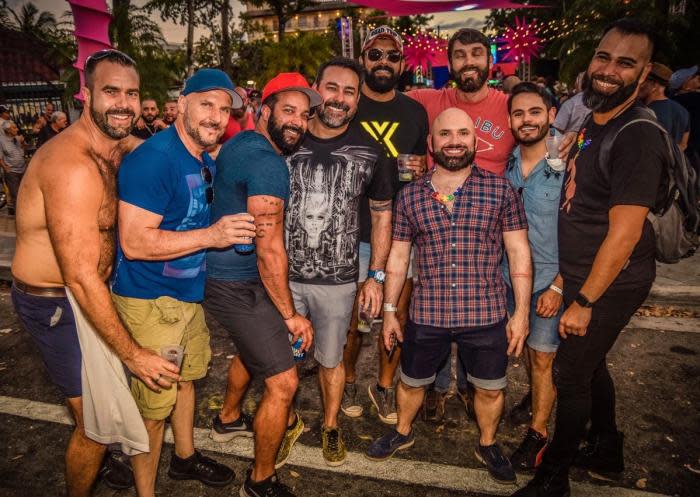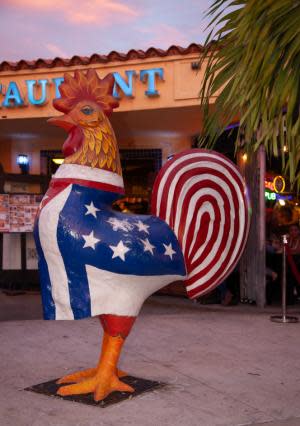Written by: Ivan Quintanilla
This article originally appeared on EDGE Media Network
"There is no one more American than a Miami Cuban, and there is no one more Cuban than a Miami Cuban," says Rodrigo, who I meet at the rum bar in Little Havana's Cubaocho museum and performing arts center while waiting for my late friends (a very Miami trait!). "You'll never find a people more patriotic to two homelands."
The Miami Cuban community is not monolithic. We are Republicans, Democrats, Catholics, and Santeros. We are the conservative, mostly-white business owners who fled Cuba in the early '60s, and the queer Afro-Cuban artists who were among the 125,000 Cuban immigrants who arrived during the 1980 Mariel boatlift. And we are everything in between and beyond. But if there's one thing that has become crystal clear as thousands march in Miami in solidarity with Cuban protestors, it's that Rodrigo was right: "You'll never find a people more patriotic to two homelands."
Nowhere do these co-existing allegiances converge more than in today's Little Havana, the Miami neighborhood where Cubans started settling after the 1959 Cuban Revolution. Little Havana is a funky mix of cultures. It is a place where old-world traditions blend with progressive thinking — where machismo and queerness cohabitate.
Calle Ocho (8th Street) is the center of all things Little Havana. The popular tourist strip between 12th and 17th avenue emerged in the new millennium, as the revitalization of the area's art scene attracted new visitors. Here, Spanish is the default language, salsa music blares from storefronts, and the smell of Cuban coffee permeates the air. This is the Little Havana you'll see on tourism websites, dotted with colorful murals and rooster sculptures, a cultural symbol for Cubans.
However, an authentic culture thrives alongside the steady tourist traffic. Businesses like the family-run fruit market Los Pinareños Fruteria have been making fresh guarapo (sugar cane juice) since the 1960s. Down the street, the Asis-Lopez family's Havana Collection retail store has been dressing the neighborhood in the quintessential Cuban look, the Guayabera shirt, since 1972.

In 1980, Miami Cuban culture got a lot queerer. For Fidel Castro, the opening of Cuba's Mariel Harbor and six-month boatlift for those wanting to leave the island was a way to purge the "undesirables." For LGBTQ Cubans, it was an opportunity to escape persecution and imprisonment.
"There was a creative takeover after the Mariel," says "A History of Little Havana" co-author Corinna J. Moebius. "Artists, theater folks, and transformistas (drag queens) that had been in the underground of Havana were liberated... Yet, this is all happening in a district where these straight-laced guys have been trying to portray this hyper-masculinity."
Thousands of queer men and women immigrated to the United States during the Mariel boatlift, many of them eventually settling in Little Havana. One of them was Luis Molina, the gay artist and owner of Molina Fine Art Gallery & Studio. His vibrant art focuses on Cuban and Afro-Cuban themes, including religious imagery, Santeria, farming landscapes and — yes — roosters. Today, his gallery space is among the oldest on Calle Ocho.
"There is an erasure of the contributions of the Afro-Cuban and LGBTQ communities in Little Havana," says Moebius. "The dominant story is that it all goes back to the guys who arrived in the 1960s, whereas if you really look at what made Little Havana truly thriving and a popular tourist destination, it was that creative stimulus."

Luckily for today's LGBTQ visitors, creativity has continued building bridges in the community. Little Havana now hosts the Gay8 ("Gay Ocho") Festival every year, billed as the largest Latino LGBTQ festival in America.
"Miami can be very segregated. We are diverse, but we are more like a salad and we wanted to be the salad bowl. We wanted to encompass all these different groups and create convergence. It's not just existing on a corner where you intersect. It's actually making an effort to learn about other people's experiences," says Damian Pardo, co-founder of Gay8 and Chair of 4Ward Miami, an organization with programs that advance community engagement, social justice, and cultural arts. "We decided to use a festival because through music, food, and art, you're going get a crowd that is representative of the diversity you want to create."
Next scheduled for February 13, 2022, and promoting the theme of "Freedom," Gay8 will connect dots between marginalized communities in the U.S. and those speaking out against the oppressive Cuban regime on the island, all while featuring live music, DJs, and screenings of LGBTQ foreign films in Little Havana's Tower Theater.
And, apparently, it's working. "The festival has really helped to make the area more open because everyone is invited, from shirtless guys to abuelitas," says Molina.
To further explore the local art scene, head to Futurama, a shared space where multiple artists create, exhibit, and sell their work. For an art-inspired party, plan to visit during Viernes Culturales, when art, music, and drinks take to the streets every third Friday of the month.
Cubaocho, where I first met Rodrigo, has become the neighborhood's cultural hub, and includes an art museum, live music venue, café, restaurant, and bar (boasting an extensive rum collection). The space is exceptional, and the owners are vocal allies for the LGBTQ community. During June, CubaOcho hosted a special Pride party, and they work intimately with Gay8.
For the full-throttle LGBTQ Latin nightlife experience, you'll have to drive a short distance out of Little Havana to Azucar Nightclub. Currently the only LGBTQ Latin club in the area, Azucar is co-owned by Alexis Fernández, the Cuban drag artist best known as Marytrini. The club has stood the test of time and gentrification for over 20 years. Every Thursday through Sunday, the evening starts with drag shows and ends with dancing for Miami's extensive Spanish-dominant-speaking queer community.

Back in Little Havana, you'll want to stroll through the Calle Ocho Walk of Fame, honoring famous Latin artists like Celia Cruz and Gloria Estefan, and make your way toward one of the area's most iconic spots, Domino Park. Here, you'll see the neighborhood elders playing the popular game all day long.
And you are going to want to eat — a lot. On every corner, you'll find a delicious Cuban restaurant that serves big meals at affordable prices.
Favorite Cuban restaurants in Little Havana and Miami include Old's Havana, El Pub, and (though a short drive away) the Miami Cuban staples of Versailles and La Carreta. But save room for dessert back on Calle Ocho: A scoop of "Abuela Maria" with a guava swirl from Azucar Ice Cream Company is mandatory.
As a Cuban kid growing up in Miami, Cuban culture wasn't anything I sought out. I didn't have to. It was all around me. Now, 25 years after leaving the city — and as the world watches the largest protests on the island in decades — I realize that Miami will always be home. And I'm especially proud of the contributions of my people — Cuban and LGBTQ — and how those intersecting groups continue to expand the American Dream in Little Havana to be a little more inclusive.
Where to Stay
You're more likely to find a charming Airbnb cottage in Little Havana rather than a sprawling hotel. Rooms at the Selina Hotel in the adjacent Miami River district range from micro-rooms to spacious apartments, appropriate for various budgets. In the nearby neighborhood of Brickell, the W Miami is a perfect upscale option, and just a short drive away from Calle Ocho.